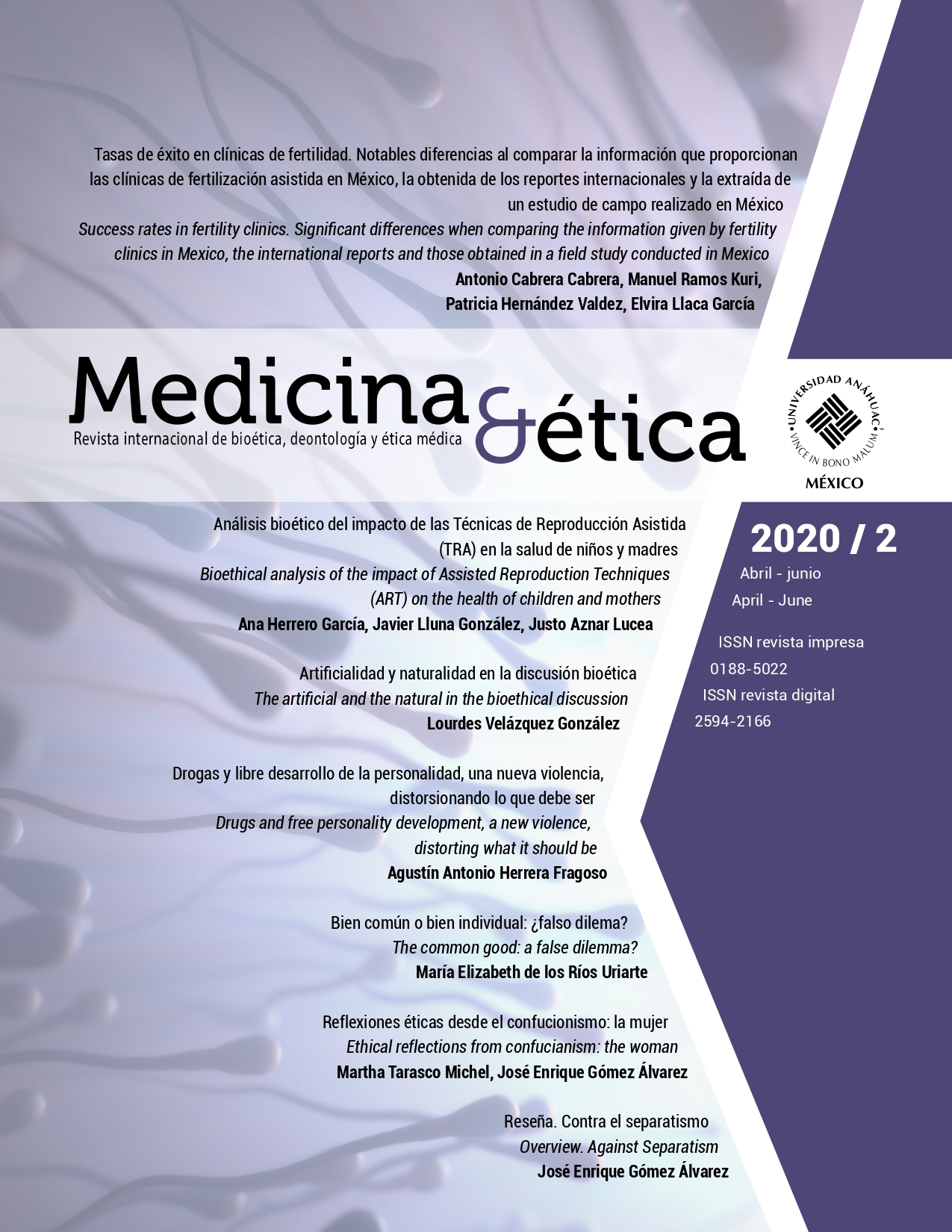Success rates in fertility clinics Significant differences when comparing the information given by fertility clinics in Mexico, the international reports and those obtained in a field study conducted in Mexico
Main Article Content
Abstract
A highly significant issue related to the frequent problem of infertility, is the high expectative of success when couples go to a fertility clinic, in order to perform procedures like In vitro Fertilization (FIVET), Intracytoplasmic Sperm Injection (ICSI) or Artificial Insemination. The success index announced by the fertility clinics use to be as high as 60% or even 90%. Although this index has always seemed exceedingly high, it has never been proven. Then, the present paper compares the success rates announced by fertility clinics in their web pages, with those obtained by three different sources: the international reports from the European Society of Human Reproduction and Embryology (ESHRE) and from the RED LARA (Latin American Network of Assisted Reproduction) as well as a field study conducted in Mexico. The results show very significant differences, thus analyzing the reasons for these discrepancies, highlighting the importance and advantages, for patients and even for the health staff, by offering trustworthy and comprehensive assistance to infertile couples. This especially due to the high vulnerability of those couples in an infertility situation, and by exploring the current information ecosystem on the topic of infertility in Mexico.
Downloads
PLUMX Metrics
Article Details

This work is licensed under a Creative Commons Attribution-NonCommercial-ShareAlike 4.0 International License.
Medicina y Ética is distributed under a Creative Commons License Atribución-NoComercial-CompartirIgual 4.0 Internacional.
The author keeps the property rights with no restriction whatsoever and guarantees the magazine the right to be the first publication of the work. The author is free to deposit the published version in any other medium, such as an institutional archive or on his own website.
References
(2) ZAMORA, R. ¿Cómo se garantiza la atención obstétrica después de la reproducción asistida? Ginecología y Obstetricia de México. 2019; 87(01): 1-3.
(3) WALKER, E., FERNÁNDEZ, P., & SUÁREZ, L. Infertilidad. Recuperado en: http://
www.crim. unam.mx/drupal/crimArchivos/Colec_Dig/2007/A.
(4) CABRERA, C. A. La atención integral a las personas con problemas de fertilidad: estudio de campo realizado en México. Roma: Ateneo Pontificio Regina Apostolorum; 2011. Recuperado en: http://pegaso.anahuac.mx/accesoabierto/publicaciones.php?Accion=Informacion&Palabras=cabrera&Pub=120
(5) LLAVONA, L. M. El impacto psicológico de la infertilidad. Papeles del Psicólogo: Revista del Colegio Oficial de Psicólogos. 2008; 29(2): 158-166.
(6) DONATI, P. Trasformazioni socio-culturali della famiglia e comportamenti relativi alla procreazione. Medicina e Morale. 1993; 1: 117-163.
(7) MORENO-ROSSET, C. Ansiedad y depresión: principales trastornos asociados a la infertilidad. Información Psicológica. 2000; 73(12): 12-19.
(8) RAMIREZ MORAN, A. F., CALA BAYEUX, Á., FAJARDO IGLESIA, D., & SCOTT GRAVE DE PERALTA, R. Factores causales de infertilidad. Revista Información Científica. 2019; 98(2): 283-293.
(9) ÁLVAREZ MORALES, N. E., HERNÁNDEZ, L. A., & RODRÍGUEZ LAFUENTE, M. E. Bienestar psicológico y ansiedad rasgo-estado en miembros de parejas con infertilidad primaria. Medimay. 2019; 26(1): 77-89.
(10) PEÑARRUBIA, J., GARCÍA-VELASCO, J. A., & LANDERAS, J. Modelos predictivos en reproducción asistida: revisión sistemática y análisis crítico. Medicina Reproductiva y Embriología Clínica. 2019; 6(2): 63-74. https://doi.org/10.1016/j.medre. 2019.05.001
(11) DELGADO, C. A. La reproducción asistida en los tiempos de la globalización: un crisol de perspectivas, una red de conexiones. Revista de Antropología Social. 2019; 28(1): 191. https://doi.org/10.5209/raso.63775
(12) ZEGERS-HOCHSCHILD, F., GALMES, V., & SCHWARCE, J. E. Registro de Reproduccón Asistida 2005. Recuperado en: http://www.redlara.com/ing/reg_2005.asp.
(13) NYBOE, A., GOOSENS, V., BHATTACHARYA, S., FERRARETTI, A. P., KUPKA, M. S., DE MOUZON, J., & NYGREN, K. G. Assisted reproductive technology and intrauterine inseminations in Europe, 2005: Results generated from European registers by ESHRE. Human Reproduduction. 2009; 24 (6): 1267-1287. https://doi.org/10.1093/
humrep/dep035
(14) MORAGIANNI, V. A., PENZIAS, A. S. Cumulative live-birth rates after assisted reproductive technology. Current Opinion in Obstetrics and Gynecology. 2010; 22(3): 189-192. https://doi.org/10.1097/gco.0b013e328338493f
(15) EDWARDS RG. IVF, IVM, natural cycle IVF, minimal stimulation IVF «time for a rethink. Reproductive BioMedicine. 2007; 15(1): 106-119. https://doi.org/10.1016/s1472-6483(10)60699-2
(16) SHANNER L, NISKER J. Bioethics for clinicians: 26. Assisted reproductive Technologies. Canadian Medical Association Journal. 2001; 1641(11): 1589-1594.
(17) CÁRDENAS KRENZ R. Fecundación asistida y consentimiento informado: ¿Qué tan informado es dicho consentimiento? Lumen. 2015; 11: 19-31. https://doi.org/10.33539/lumen.2015.n11.542

